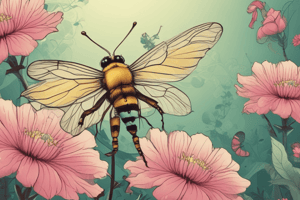Podcast
Questions and Answers
What is the term for the transfer of pollen grains from the anther of one flower to the stigma of a genetically different flower?
What is the term for the transfer of pollen grains from the anther of one flower to the stigma of a genetically different flower?
- Bud Pollination
- Cleistogamy
- Cross-pollination (correct)
- Homogamy
In insect-pollinated flowers, what color petals are often associated with bee-pollinated flowers?
In insect-pollinated flowers, what color petals are often associated with bee-pollinated flowers?
- Purple
- Yellow (correct)
- Red
- Blue
What is the term for a perfect flower being pollinated by its own pollen?
What is the term for a perfect flower being pollinated by its own pollen?
- Homogamy
- Cleistogamy
- Autogamy (correct)
- Bud Pollination
Which external agents can assist in pollinating flowers according to the text?
Which external agents can assist in pollinating flowers according to the text?
In heteromorphic flowers, where is the stigma located?
In heteromorphic flowers, where is the stigma located?
What is the term for flowers that remain closed causing self-pollination?
What is the term for flowers that remain closed causing self-pollination?
What is the purpose of the small and sticky stigma in flowers?
What is the purpose of the small and sticky stigma in flowers?
Which type of pollen grains are typically found in insect-pollinated flowers?
Which type of pollen grains are typically found in insect-pollinated flowers?
What is the main characteristic of wind-pollinated flowers?
What is the main characteristic of wind-pollinated flowers?
What does the term 'co-evolution' refer to in the context of flowers and insects?
What does the term 'co-evolution' refer to in the context of flowers and insects?
Which feature is common in insect-pollinated flowers but absent in wind-pollinated flowers?
Which feature is common in insect-pollinated flowers but absent in wind-pollinated flowers?
What distinguishes male flowers in wind-pollinated plants from those in insect-pollinated plants?
What distinguishes male flowers in wind-pollinated plants from those in insect-pollinated plants?
What term describes the maturation of male parts before female parts in a bisexual flower?
What term describes the maturation of male parts before female parts in a bisexual flower?
Which mechanism involves the structure of male and female sex organs creating a spatial barrier to self-pollination?
Which mechanism involves the structure of male and female sex organs creating a spatial barrier to self-pollination?
What type of flowers have different morphs depending on the length of the style and stamen?
What type of flowers have different morphs depending on the length of the style and stamen?
Which adaptation ensures that pollination occurs only between two dissimilar types of flowers?
Which adaptation ensures that pollination occurs only between two dissimilar types of flowers?
In which mechanism do populations have multiple floral morphologies that differ in style orientation?
In which mechanism do populations have multiple floral morphologies that differ in style orientation?
Which term refers to the temporal separation of male and female organ maturation in a bisexual flower?
Which term refers to the temporal separation of male and female organ maturation in a bisexual flower?
Study Notes
Insect-Pollinated Flowers
- Anthers are located inside the flower where insects brush past the stigma, allowing pollen grains to attach to the insect's body.
- Stigma is usually small and sticky to enable pollen grains to attach.
- Flowers often have strong scents, essential oils, and nectar guides to attract insects.
- Large, sticky, and spiky pollen grains are produced in few numbers to ensure they stick to insects.
- Examples of insect-pollinated flowers include Jasmine, Viola, and Clematis.
Co-evolution
- Co-evolution occurs when one species evolves a new feature or modifies itself, and the other species evolves new adaptations in response.
Wind-Pollinated Flowers
- Petals are small or absent, and if present, they are not brightly colored.
- Stigma is exposed to catch pollen grains blown by the wind.
- Long stamens and anthers are exposed to the outside to allow wind to easily blow pollen grains away.
- Stigma is large and feathery to catch pollen grains.
- Examples of wind-pollinated flowers include those with no scent or nectar, and light and smooth pollen.
Cross-Pollination
- Various mechanisms and adaptations are seen in cross-pollinated flowers to facilitate cross-pollination over self-pollination.
- Examples of mechanisms include dichogamy, herkogamy, flexistyly, heterostyly, and self-incompatibility.
Cross-Pollination Mechanisms
- Dichogamy: Maturation of male and female organs at different times in a bisexual flower.
- Herkogamy: Spatial barrier between male and female sex organs to prevent self-pollination.
- Flexistyly: Populations with multiple floral morphologies that differ in their style orientation.
- Enantiostyly: Mirror image flowers with the style bending either to the left or right side of the floral axis.
- Heterostyly: Flowers of different types (morphs) depending on the length of the style and stamen, with pollination occurring only between two dissimilar types.
- Self-incompatibility: Genetic mechanisms to prevent self-pollination, often with modifications similar to those found in cross-pollination.
Autogamy and Self-Pollination
- Autogamy: Perfect flower is pollinated by its own pollen.
- Homogamy: Maturation of anthers and stigma of a flower at the same time.
- Cleistogamy: Flowers remain closed, causing self-pollination.
- Bud Pollination: Perfect flowers ripen before the opening of the buds.
Examples of Cross-Pollination and Self-Pollination
- Examples of cross-pollination include apples, grapes, plums, pears, raspberries, blackberries, strawberries, runner beans, pumpkins, daffodils, tulips, and lavender.
- Examples of self-pollination include autogamy, homogamy, cleistogamy, and bud pollination.
Studying That Suits You
Use AI to generate personalized quizzes and flashcards to suit your learning preferences.
Description
Test your knowledge on pollination mechanisms and the concept of co-evolution in plants. Learn about the role of anthers, stigma, pollen grains, essential oils, and nectar guides in the pollination process. Explore how plants and insects have co-evolved over time.




